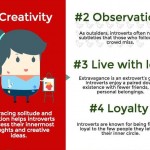
Extroverts and introverts have different learning preferences. For extroverted students participating in groups often comes easily. Introverted students may have no problem sitting and listening to lectures. However, even though not all introverts are shy, they may have more difficulty participating in groups.
Educators often reward the natural tendency of extroverts to participate. For this reason, they need to keep the learning preferences of students in mind and make sure they give introverted students ways to engage in learning that suits their temperament. Even if an introvert studies alone or uses a paper writing service, they may still feel overwhelmed by the amount of group work they face.
They need solitude to refuel
Educators need to consider how to foster learning in a comfortable and yet challenging way to both introverts and extroverts. For example, extroverts and introverts have different attitudes towards solitude and social contact.
Extroverts are fuelled by social interaction whereas introverts usually need solitary time to refuel after social interaction. Introverts often appreciate the opportunity to look over class materials at their own pace. Educators should give them time to think and write before asking them to speak. They should also have the opportunity to be assessed through written work, rather than having to make oral presentations.
They may need writing help
Essay writing can be a challenge to all students of every temperament when they are getting an education at college or university. Essay examples can be a great help to them, showing them what’s expected in terms of structure, language and referencing. They can find inspiration and improve their grades. Leading free essay service WritingBros offers writing help for introverts. The service provides a large database of essays that covers many subjects in the curriculum. Its goal is to help students excel in academic writing.
They have different challenges
Educators need to be wary of structuring their courses in a way that challenge introverts but does not stretch extroverts in the same way. They will often demand that introverts “speak up” and “participate more.” If the classroom situation is to be fair for all students, both introverts and extroverts need to be challenged in the areas where they need to grow.
It may be a challenge for an extrovert to sit still and concentrate, whereas this does not challenge an introvert. Rather than trying to protect introverts, educators need to first understand an introvert’s fears and then encourage them to overcome them and take risks. Introverts can benefit from practicing articulating their ideas in groups and learning from the perspective of others.
They have unique strengths
Introverts and extroverts also have different strengths. Rather than trying to turn introverts into extroverts, their individual strengths need fostering. Introverts do not have less to offer than extroverts. The ability to be seen, heard and stand out in the crowd is valued today and this causes a cultural bias in favor of extroverts.
While extroverts are often confident and articulate, introverts are able to listen carefully to others and empathize with them. These traits are just as necessary. The gifts of introverted students may be less attention-getting but they are no less significant. Their thoughtfulness and inward-thinking nature gives them a perspective others can learn from.
They prefer to work independently in a calm setting
Introverts prefer to listen more than speak, observe more than being the center of attention, and think before they speaking. They may feel anxious and over-stimulated if they have too much exposure to people and interaction. The active learning favored today suits the outgoing, outspoken traits of the extrovert.
As introverted students prefer to work independently and in a calm setting, educators need to give them this opportunity. A classroom with only communal zones generates communal activity. Creating smaller quiet nooks encourages an atmosphere conducive to reflective thinking and learning.
They need time to organize their thoughts before sharing
Educators who don’t call on students straight after posing a question drive home the lesson that they need to put thought into an answer before sharing it. Introverts like to gather their thoughts without the immediate pressure to say something.
Educators need to make participation about quality, not quantity. This can level the playing field and dissuade extroverts from blurting out the first thing that comes into their heads.
A final word
Many classroom environments encourage extroverted behavior through collaborative, active learning but the inward-thinking needs of the introverted student are often neglected.
Teaching introverted students in a way that suits their personality type is critical for their future success. Educators need to plan their lessons to accommodate the needs and learning styles of introverted students. Acknowledging them for who they are will help them to find their place in the world.
Author’s Bio:
Vendy Adams has what it takes for a writer to be known as a skilled, professional, subject expert and loved by the readers. She writes academic papers, blogs, web content and short stories for kids and in everything she does, she is always at the top of her job. There’s only one thing she does when not writing – one stroke painting, which she just loves immensely.










